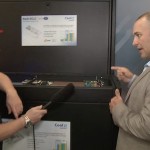In this video from the 2014 HPC Advisory Council Europe Conference, Rich Graham from Mellanox presents: Scalable HPC Communication Capabilities.
How the NREL Peregrine Supercomputer Sets the Bar for Energy Efficiency
In this video from ISC’14, Steve Hammond from NREL and Nic Dube from HP describe the energy efficient Peregrine supercomputer at the National Renewable Energy Lab. As a prototype for the HP Apollo 8000 system, Peregrine has achieved a remarkable 1.05 PUE rating for energy efficiency.
Xyratex/Seagate Update from ISC’14
In this video from ISC’14, Torben Kling-Petersen describes the latest technology news from Xyratex. The company’s ClusterStor technology for Lustre storage has just landed a major win with Bull at DKRZ.
Satoshi Matsuoka Presents: A Look at Big Data in HPC
In this video from the DDN User Group at ISC’14, Satoshi Matsuoka from the Tokyo Institute of Technology presents: A Look at Big Data in HPC. “HPC has been dealing with big data for all of its existence. But it turns out that the recent commercial emphasis on big data, has coincided with a fundamental change in the sciences as well. As scientific instruments and facilities produce large amounts of data in an unprecedented rate, the HPC community is reacting to this, with revisiting architecture, tools, and services to address this growth in data.”
International Exascale Workshop Culminates with US-Japan Collaboration Agreement
On June 22, the US Department of Energy (DOE) and Japan’s Ministry of Education, Culture, Sports, Science and Technology (MEXT) signed an agreement to collaborate on exascale supercomputing technologies for the scientific community. In a nutshell, the plan is to build a common OS kernel that can be used by all post-petascale systems, regardless of hardware eccentricities.
Sugon Unveils Liquid-cooled Prototype at ISC’14
In this video from ISC’14, Shen Weidong from Sugon describes the company’s liquid-cooled “personal supercomputer” prototype designed to run in office environments. “The PHPC300 has 12 blades. Each blade is a sealed box with (3M Novec) liquid in it with a boiling point of about 50 degrees Celsius. So the liquid near the CPU will evaporate and then be circulated to a condenser where it is turned back into a liquid. We can use this technology in China to achieve a PUE of 1.05.”
Intel Enterprise Edition for Lustre Software at ISC’14
“The Intel Enterprise Edition for Lustre software unleashes the performance and scalability of the Lustre parallel file system for HPC workloads, including technical ‘big data’ applications common within today’s enterprises. It allows end-users that need the benefits of large–scale, high bandwidth storage to tap the power and scalability of Lustre, with the simplified installation, configuration, and management features provided by Intel Manager for Lustre software, a management solution purpose-built by the Lustre experts at Intel for the Lustre file system.”
CoolIT Systems Showcases Liquid Cooling for HPC at ISC’14
In this video from ISC’14, Geoff Lyon from CoolIT Systems describes the company’s innovative liquid cooling systems for HPC datacenters. “CoolIT is featuring the full spectrum of DCLC solutions which can be configured to meet a range of performance, density and efficiency requirements. On display will be the Liquid-to-Air AHx and the Liquid-to-Liquid CHx systems in 45U, 25U and 12U arrangements. The Rack DCLC product range supports ultra-high density data center designs with blade and other multi-node chassis servers.”
Asetek Shows Growing Momentum for Liquid Cooling at ISC’14
In this video from ISC’14, Steve Branton from Asetek describes a series of high profile supercomputing installations that show the growing momentum of Asetek liquid cooling in the HPC market. “Asetek’s liquid cooling innovations for HPC and data centres address key European issues of high energy costs, the need for “green” technology and the importance of waste energy reuse.” said André Sloth Eriksen, Founder and CEO of Asetek.
How PBS Pro Maximizes HPC Utilization at the Weizmann Institute
“The Weizmann Institute replaced Moab with PBS Professional to manage a 3,096-core HP cluster shared among hundreds of users. The transition process was easy, thanks to Altair’s excellent customer services and support. Now, the Institute enjoys higher cluster usage rates and greater productivity from their award-winning scientists.”












